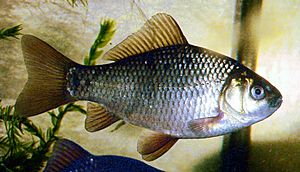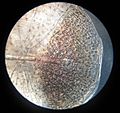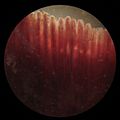Crucian carp facts for kids
Quick facts for kids Crucian carp |
|
|---|---|
 |
|
| Conservation status | |
| Scientific classification | |
| Synonyms | |
|
The crucian carp (Carassius carassius) is a medium-sized fish. It belongs to the common carp family, called Cyprinidae. You can find it in many parts of northern Europe. Its name comes from an old German word, karusse.
Contents
Where Crucian Carp Live
The crucian carp lives across Europe, from England all the way to Russia. You can find them as far north as the Arctic Circle in places like Norway and Sweden. They also live south in central France and near the Black Sea.
These fish like to live in lakes, ponds, and slow-moving rivers. Scientists have confirmed that the crucian carp is naturally found in England. It was not brought there by people.
What Crucian Carp Look Like
The crucian carp is a medium-sized fish. It is usually about 15 centimetres (5.9 in) long. It rarely weighs more than 2 kilograms (4.4 lb). However, some have been found to be 64 centimetres (25 in) long. The heaviest one ever recorded weighed 3 kilograms (6.6 lb).
Young crucian carp are often golden-bronze in color. As they get older, their color changes. Their back becomes dark green, their sides turn deep bronze, and their belly becomes gold. Their fins are often reddish or orange.
One way to tell a crucian carp apart is its rounded fin. Other fish, like goldfish or their hybrids, have fins that curve inward.
Crucian Carp and Goldfish Hybrids
Sometimes, crucian carp can breed with domestic or wild goldfish. This creates a mix, or "hybrid," fish. Scientists have even made these hybrids in labs.
These hybrid fish are usually unable to have babies of their own. However, they can be stronger and better at finding food. They are also better at escaping predators than their parents. This strength could be a problem for the natural crucian carp population.
How Crucian Carp Defend Themselves
Crucian carp can change their body shape to protect themselves. If there are fish that want to eat them in the water, the carp can become deeper and taller. This makes it much harder for predators to swallow them.
However, this change in body shape is not permanent. It also has some downsides. Deeper-bodied carp might have weaker immune systems. They also grow slower than carp with a sleeker body shape.
Amazing Survival Skills
Crucian carp have amazing ways to survive in tough environments. For example, in winter, if the water has no oxygen at all, they can still live for a long time. They do this by making alcohol inside their bodies. This is very unusual for animals with backbones!
Even in summer, they can survive without oxygen for a short time. In cold water, they can last even longer, sometimes for weeks. This is because their bodies slow down in the cold. The fish mostly release the alcohol into the water. This stops it from building up to dangerous levels inside them. This special ability helps them survive when other fish cannot.
Fishing for Crucian Carp
In Britain, catching crucian carp with a rod and line is a popular sport. It is part of "coarse fishing." The biggest crucian carp ever caught in Britain weighed four pounds, nine ounces (2.085 kg). This record was set in 2003 and tied in 2011.
Sometimes, people catch fish that look like crucian carp but are actually hybrids. These are often a mix of crucian carp and goldfish. These "fake" crucians do not count for record-breaking catches.
Crucian Carp vs. Goldfish
It can be tricky to tell a true crucian carp from a goldfish hybrid. Here are some ways to tell them apart:
| Crucian Carp (C. carassius) | Goldfish (C. auratus) |
|---|---|
| a) Has a nicely rounded snout (nose area). | a) Has a more pointed snout. |
| b) Always golden-bronze in color. | b) Often has a grey or greenish color. |
| c) Has 31 to 36 scales along its side (lateral line). | c) Has 27 to 31 scales along its side. |
| d) Young fish have a black spot near their tail. This spot disappears as they get older. | d) This tail spot is never present. |
| e) The first ray (spine) of its top fin is weak. | e) The first ray of its top fin is strong. |
| f) The top fin is taller and has a rounded (convex) shape. | f) The top fin has a curved inward (concave) shape. |
| g) Its tail fin is rounded. | g) Its tail fin is deeply forked and sharp. |
Uses of Crucian Carp
Crucian carp are sometimes kept as pets in freshwater aquariums. They are also found in outdoor water gardens. However, they are not as popular as colorful fish like koi or orfe.
In some countries, crucian carp are eaten. In Poland, crucian carp (called karaś) is thought to be a very tasty fish. It is often served with sour cream. In Russia, the "golden crucian" is used in a soup called borscht. It is also a classic dish when fried in sour cream.
Images for kids
See also
 In Spanish: Carpín para niños
In Spanish: Carpín para niños







